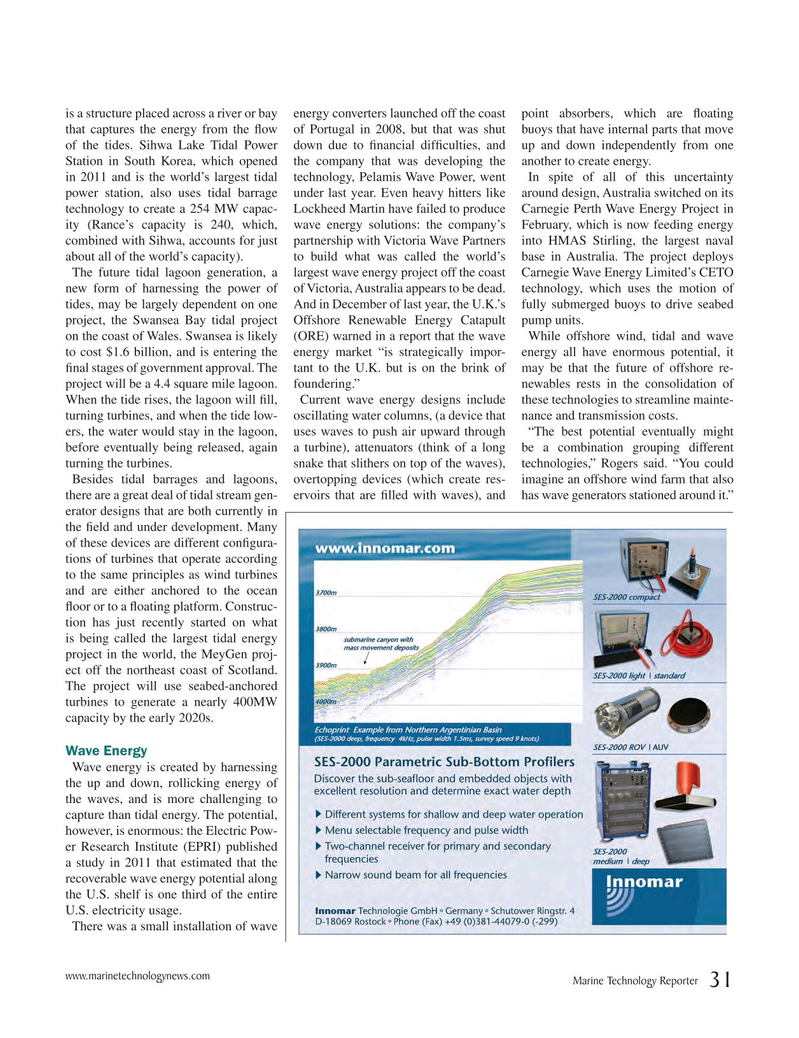
Page 31: of Marine Technology Magazine (June 2015)
Hydrographic Survey
Read this page in Pdf, Flash or Html5 edition of June 2015 Marine Technology Magazine
is a structure placed across a river or bay energy converters launched off the coast point absorbers, which are ? oating that captures the energy from the ? ow of Portugal in 2008, but that was shut buoys that have internal parts that move of the tides. Sihwa Lake Tidal Power down due to ? nancial dif? culties, and up and down independently from one
Station in South Korea, which opened the company that was developing the another to create energy.
in 2011 and is the world’s largest tidal technology, Pelamis Wave Power, went In spite of all of this uncertainty power station, also uses tidal barrage under last year. Even heavy hitters like around design, Australia switched on its technology to create a 254 MW capac- Lockheed Martin have failed to produce Carnegie Perth Wave Energy Project in ity (Rance’s capacity is 240, which, wave energy solutions: the company’s February, which is now feeding energy combined with Sihwa, accounts for just partnership with Victoria Wave Partners into HMAS Stirling, the largest naval about all of the world’s capacity). to build what was called the world’s base in Australia. The project deploys
The future tidal lagoon generation, a largest wave energy project off the coast Carnegie Wave Energy Limited’s CETO new form of harnessing the power of of Victoria, Australia appears to be dead. technology, which uses the motion of tides, may be largely dependent on one And in December of last year, the U.K.’s fully submerged buoys to drive seabed project, the Swansea Bay tidal project Offshore Renewable Energy Catapult pump units. on the coast of Wales. Swansea is likely (ORE) warned in a report that the wave While offshore wind, tidal and wave to cost $1.6 billion, and is entering the energy market “is strategically impor- energy all have enormous potential, it ? nal stages of government approval. The tant to the U.K. but is on the brink of may be that the future of offshore re- project will be a 4.4 square mile lagoon. foundering.” newables rests in the consolidation of
When the tide rises, the lagoon will ? ll, Current wave energy designs include these technologies to streamline mainte- turning turbines, and when the tide low- oscillating water columns, (a device that nance and transmission costs. ers, the water would stay in the lagoon, uses waves to push air upward through “The best potential eventually might before eventually being released, again a turbine), attenuators (think of a long be a combination grouping different turning the turbines. snake that slithers on top of the waves), technologies,” Rogers said. “You could
Besides tidal barrages and lagoons, overtopping devices (which create res- imagine an offshore wind farm that also there are a great deal of tidal stream gen- ervoirs that are ? lled with waves), and has wave generators stationed around it.” erator designs that are both currently in the ? eld and under development. Many of these devices are different con? gura- tions of turbines that operate according to the same principles as wind turbines and are either anchored to the ocean ? oor or to a ? oating platform. Construc- tion has just recently started on what is being called the largest tidal energy project in the world, the MeyGen proj- ect off the northeast coast of Scotland.
The project will use seabed-anchored turbines to generate a nearly 400MW capacity by the early 2020s.
Wave Energy
Wave energy is created by harnessing the up and down, rollicking energy of the waves, and is more challenging to capture than tidal energy. The potential, however, is enormous: the Electric Pow- er Research Institute (EPRI) published a study in 2011 that estimated that the recoverable wave energy potential along the U.S. shelf is one third of the entire
U.S. electricity usage.
There was a small installation of wave www.marinetechnologynews.com
Marine Technology Reporter 31
MTR #5 (18-33).indd 31 MTR #5 (18-33).indd 31 6/11/2015 10:01:19 AM6/11/2015 10:01:19 AM

 30
30

 32
32
